› Forums › Security › Discussions (Security) › Planting Tiny Spy Chips in Hardware Can Cost as Little as $200
Tagged: SIServices_S13
- This topic has 1 voice and 0 replies.
-
AuthorPosts
-
-
December 12, 2019 at 5:17 am #37337
#News(IoTStack) [ via IoTGroup ]
Headings…
Planting Tiny Spy Chips in Hardware Can Cost as Little as $200Auto extracted Text……

More than a year has passed since Bloomberg Businessweek grabbed the lapels of the cybersecurity world with a bombshell claim: that Supermicro motherboards in servers used by major tech firms, including Apple and Amazon, had been stealthily implanted with a chip the size of a rice grain that allowed Chinese hackers to spy deep into those networks.
Now researchers have gone further, showing just how easily and cheaply a tiny, tough-to-detect spy chip could be planted in a company’s hardware supply chain.
At the CS3sthlm security conference later this month, security researcher Monta Elkins will show how he created a proof-of-concept version of that hardware hack in his basement.
He intends to demonstrate just how easily spies, criminals, or saboteurs with even minimal skills, working on a shoestring budget, can plant a chip in enterprise IT equipment to offer themselves stealthy backdoor access.
(Full disclosure: I’ll be speaking at the same conference, which paid for my travel and is providing copies of my forthcoming book to attendees.) With only a $150 hot-air soldering tool, a $40 microscope, and some $2 chips ordered online, Elkins was able to alter a Cisco firewall in a way that he says most IT admins likely wouldn’t notice, yet would give a remote attacker deep control.
“We think this stuff is so magical, but it’s not really that hard,” says Elkins, who works as “hacker in chief” for the industrial-control-system security firm FoxGuard.
Elkins used an ATtiny85 chip, about 5 millimeters square, that he found on a $2 Digispark Arduino board; not quite the size of a grain of rice, but smaller than a pinky fingernail.
After writing his code to that chip, Elkins desoldered it from the Digispark board and soldered it to the motherboard of a Cisco ASA 5505 firewall.
He used an inconspicuous spot that required no extra wiring and would give the chip access to the firewall’s serial port
Read More..
AutoTextExtraction by Working BoT using SmartNews 1.0299999999 Build 26 Aug 2019
-
-
AuthorPosts
- You must be logged in to reply to this topic.
